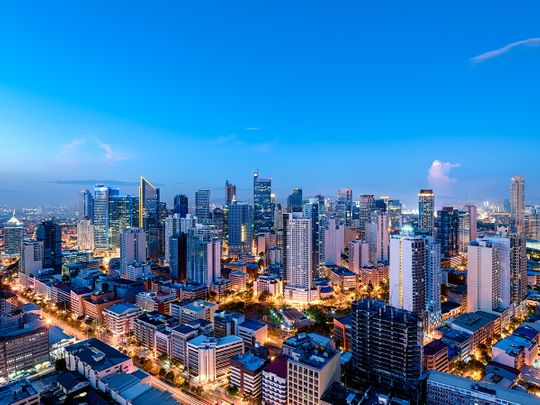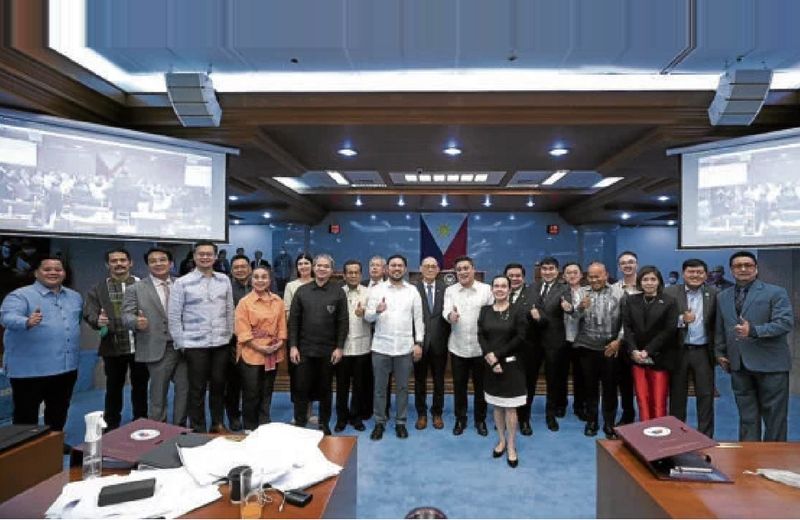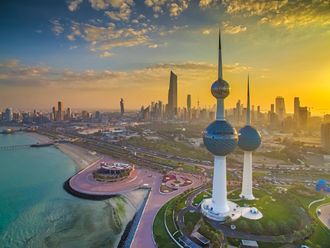
Highlights
- Once signed into law, the Maharlika Investment Fund (MIF) bill would create the country’s first sovereign wealth fund (SWF), a state-owned investment fund, thus ushering in a new economic era for the Asian nation.
- Creators of the law said enough safeguards are in place to prevent the fund from being misused, abused or siphoned off.
- Only time will tell if the good intentions behind the Senate Bil 2020 would generate value for the Filipino.
Manila: A fresh chapter has been opened in the Philippines’ economic journey. The creation of the nation's first sovereign wealth fund (SWF) is deemed a key component for unleashing its potential and propping up a mid-income nation status upgrade for the Asian country.
It all came down to lawmaking.
On Tuedsay till early Wednesday (May 30 to 31, 2023), legislators from both houses of Congress (Senate and House of Representatives), following marathon deliberations, green lighted the final version of the bill creating the Maharlika Investment Fund (MIF).
Once signed into law, it would be the country’s first sovereign wealth fund (SWF), ushering in a new era for the country in the global capitalist order.
Here’s what we know, and don't know, so far:
Why was the Maharlika Investment Fund (MIF) bill proposed?
On paper, it seeks to improve the Philippines' economic and financial status.
The Philippines already ranks among the countries with highest foreign exchange reserves, thanks to millions of overseas Filipino workers (OFWs) and billions of dollars flowing in thru its vibrant business process outsourcing (BPO) industry. That forex generator is not being harnessed enough to achieve the country's strategic economic targets.
The country also regularly posts budget surpluses, though "underspending" off the approved national budget running into billions of dollars (more on this below).
The Senate Bill 2020 (Section 2), approved by the 19th Congress on May 31, 2023 states: “It is the policy of the State to generate, preserve and grow national wealth, create jobs, promote trade and investments, foster technological transformation, strengthen connectivity, expand infrastructure, and achieve energy, water, and food security.
“The State recognizes the vital role of various investments in financial assets in promoting economic growth, accelerating job creation, and improving the welfare of Filipinos. The State acknowledges the need to preserve and optimize the use of government financial assets to generate returns, and support the infrastructure development agenda of the government, thereby promoting efficient intergenerational management of wealth.”
This is a recognition by the 19th Congress members at least on paper that the country’s wealth — including minerals (gold, copper, oil, gas, nickel, etc) belongs not only to the present generation of Filipinos but also the future.
“The State further recognizes the country’s natural capital and its role as the basis for the economy, hence the need to ensure its integrity and measure its contribution in national income accounting to improve decision making, and investments in conservation and protection of natural resources and biodiversity.
How much is the initial MIF 'seed' fund?
The approved “seed fund” is $8.9 billion (Php500 billion). The national government will be the biggest contributor to the MIF. The initial funds will be drawn from the Bangko Sentral ng Pilipinas (central bank), gaming revenue, and two government-owned banks (Land Bank and Development Bank of the Philippines, DBP).
Private financial institutions and corporations will also be allowed to invest.
What about the House version?
The Philippines has a bicameral legislative system — the House of Representatives and the Senate. The two chambers must harmonise any proposed bill before it can be signed or vetoed by the president.
The approval by the House was made by the bicameral conference committee (representing both Houses) and came less than eight hours after the Senate approved on the third and final reading its version of the measure.
The passage of the bill came about six months after the original bill was proposed in the Lower House on Nov. 28, 2022. The Lower House representatives in bicameral committee convened on Wednesday and agreed to adopt Senate Bill No. 2020.
What will the MIF do?
Essentially, the fund will be the vehicle through which national funds — financial assets owned by the government — can be invested. It is also mandated to coordinate and strengthen the investment activities of the country’s top-performing government financial institutions (GFIs) — for the purpose of promoting economic growth and social development.
Who are the authors of the Senate and House bills?
The Maharlika Investment Fund Act of 2023, was filed on March 20, 2023 by Senators Mark A. Villar, Raffy T. Tulfo and Robinhood C. Padilla, Senate members of the 19th Philippine Congress. The House version, first proposed in December 2022, enjoyed cross-party support, with dozens of authors and co-authors listed.
What about funds from Social Security System (SSS) and Government Service Insurance System (GSIS)?
Among the most crucial amendment to the Senate’s version of the measure was the prohibition of investments in the MIF from the Social Security System (SSS), Government Service Insurance System (GSIS), Philippine Health Insurance Corp., Home Development Mutual Fund, Overseas Workers Welfare Administration, and Philippine Veterans Affairs Office.
GSIS and SSS are already investing their funds like SWFs do.
Under SB 2020, MIF fund will be allowed to make a wide range of investments, including in corporate bonds, equities, joint ventures and infrastructure projects.

Where will the MIF assets be invested?
The fine print of the proposed Act prescribes the following:
- Cash, foreign currencies, metals, and other tradeable commodities
- Fixed income instruments issued by sovereigns, quasi-sovereigns and supranationals
- Domestic and foreign corporate bonds
- Listed or unlisted equities, whether common, preferred, or hybrids
- Financial derivatives
- Islamic investments, such as Sukuk bonds
- Joint Ventures or Co-Investments
- Mutual and Exchange-traded Funds
- Commercial real estate and infrastructure projects
- Other investments as may be approved by the Board.
The Maharlika Investments Corporation (MIC), which will run the fund, may spend up to 10 per cent of its gross revenue from the previous fiscal year on administrative and operational costs.
Moreover, the President of the Philippines must receive reports on MIF investment activities no later than seven (7) days after the end of each quarter, and financial statements must be submitted no later than seven (7) days after the end of each month.
What about taxes?
The MIF and the MIC shall be exempt from all direct and indirect taxes, regardless of their nature or scope. In addition, the terms of the Dividends Law (Republic Act No. 7656) would not apply to the distribution of net earnings.
What is the composition of the MIC Board?
The board would have nine members. The Finance Secretary, who represents the national government, two independent directors, and six members from the founding government financial institutions (GFIs), whose membership seats are distributed based on the proportion of their investments, would make up the MIC Board of Directors.
The Chairperson and Chief Executive Officer (CEO), who serve terms of seven (7) years, shall be descended from the founding GFI member with the biggest fund investment.
The other three members of the board would serve three-year terms, while the three normal board members would serve five-year terms. The independent directors would ultimately serve one-year tenure.
What is the board's job?
The Board of Directors' main responsibility is to run and oversee the MIF and all of its investments and assets. It is required to meet once a month, but it may schedule additional meetings for urgent concerns at the request of the chairperson and CEO or at the initiative of at least two (2) board members.
The Finance Secretary, Budget Secretary, Socioeconomic Planning Secretary, and Treasurer of the Philippines will create an Advisory Body to support the Board. They are not allowed to participate in the MIF's management or control, though.
How would the MIF assets be accounted for and protected?
Backers said the Senate’s version of the MIF made sure that it contained sufficient safeguards against possible fund misuse and abuse.
A provision stipulate a 25-per cent limit to the investible funds of (Development Bank of the Philippines) and the Landbank that would be exposed to the operations of MIF.
The MIF's financial reporting system would be completed through three tiers of audit.
- Internal auditor
- External auditor hired for a three (3) year period
- COA, or Commission on Audit
Although not specifically stated in the bill itself, a fourth layer of audit was also mentioned by supporters, particularly from the risk committees of the member GFIs.
Is the fund’s creation now a law?
It’s not yet a law.
But the proposed law (Senate Bill 2020), mandating the creation of the MIF has been approved early Wednesday morning (May 31, 2023) by the Philippine Senate vote.That means its creation is just a signature away from becoming a law of the land.
What did the opposition do/say about the fund?
Opposition Senator Risa Hontiveros introduced amendments to the bill, including the exclusion of pension (GSIS/SSS) and welfare funds, as well as the prohibition against the appointment in the Maharlika Investment Corp., the MIF management company, of persons with a “hint of corruption".
She was the lone senator who voted against the bill's passage, and thanked her colleagues for adopting the safeguards she pushed for.
House Deputy Minority Leader and ACT Teachers party-list Rep. France Castro told Philippine media: “So-called amendments on the final Senate version of the MIF cannot resolve the fact that the country does not have surplus cash and that the bulk of the money cannot come from the government."
You mentioned budget surpluses?
The Philippines DOES run budget surpluses. A huge chunk of the government budget each year is left unspent — it's called "underspending."
Examples: In 2016, official government records show Php596.7 billion in government budget was unspent. It was Php388.4 billion in 2017, or a total of Php975 billion over two years, including the first full year under former President Rodrigo Duterte. President Benigno Aquino III's time was no better or worse. But having surplus is a good thing, if it's put to good use.
In 2017, one report has it that more than 25 out of 100 pesos earmarked in the national budget — equivalent to Php828.75 billion — was "unspent".
What are the safeguards to protect the fund from misuse/abuse? Backers said the Senate’s version of the MIF made sure that it contained sufficient safeguards against possible fund misuse and abuse. A provision in the fund stipulate a 25-percent limit to the investible funds of (Development Bank of the Philippines) and the Landbank that would be exposed to the operations of MIF.
Will it be the first and only Philippine SWF?
It's not clear at this point. Salceda said: MIF “is the first but it does not have to be the last sovereign wealth fund that the government can create.”
How much money will it make for ordinary Filipinos?
Because it's an investment fund, there's no guarantee of future gains.
According Global SWF report in 2022, the size of the SWF industry increased by 6 per cent year-on-year in 2021 and exceeded the $10 trillion mark for the first time in history.
For an idea of how much SWFs earn, Norges Bank Investment Management (NBIM) - the largest SWF worldwide - had an annual average investment return of 14.5 percent in 2021, according to Statista.
If, say, a $10 billion fund earns 6 per cent a year, that's a potential income of $600 million (Php 33.6 billion); when reckoned over a 10-year period, it could generate substantial value for the owners (state).
How will the average Filipino benefit from the fund?
As the fund is state-owned, by definition it’s owned by the people, who may benefit directly or indirectly from tax breaks, dividends and income from the fund — through public services, such as infrastructure, health, education, subsidies (4Ps), and others.
What happens next?
Rep. Salceda, who headed the House technical working group on the proposed MIF, said he expects President Ferdinand "Bongbong" Marcos Jr to sign the bill before the State of the National Address, in late July 2023.Once the bill is signed and published in the national Gazette, it becomes a law.












